Human Flower Project
Search Results for:Kew
The Botanist Gene
By on February 28th, 2022 in
The Botanist Gene
Is there a plant scientist among the limbs of your family tree? What kinds of fruit do botanists bear?
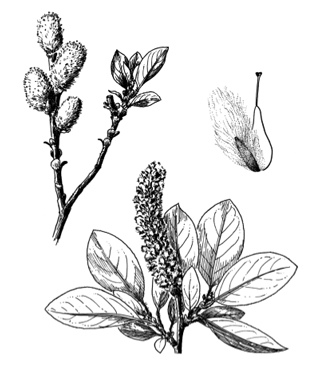
Tweedy’s Willow (Salix tweedyi): Thanks, Uncle Frank!
Image: State of Washington
Is there a gene for botanical talent? John Bartram seems to have passed it on to son William. There were the famous Hookers, father William and son Joseph, who both directed the Royal Botanic Gardens at Kew. And the Millers: Philip of the Chelsea Physic Garden and his son Charles, who became first Curator of the Cambridge Botanic Garden (1762).
On the eve the Tweedy family reunion out in Knickerbocker, Texas, this weekend, we are elated to have found a botanist-ancestor to call our own: Frank Tweedy (1854-1937). He worked for the U.S. Geological Survey in the late 19th century, exploring and collecting mainly around Yellowstone National Park, and several species from Washington State and the Rockies bear proof.
Cisanthe tweedyi (formerly known as Lewisia tweedyi) is all anyone could want for bragging rights. This beauty, native to Washington’s Cascades, is “valued by many experts as the world’s premier rock garden plant.” (Sounds like something alpine gardeners could debate long into the night.) Marc Dilley writes:
“It was named after Frank Tweedy, a U.S. Geological Survey botanical collector who made the first ascent of Mt. Stuart on August 5, 1883. Much of L. tweedyi’s renown is due to its extravagant bloom.”
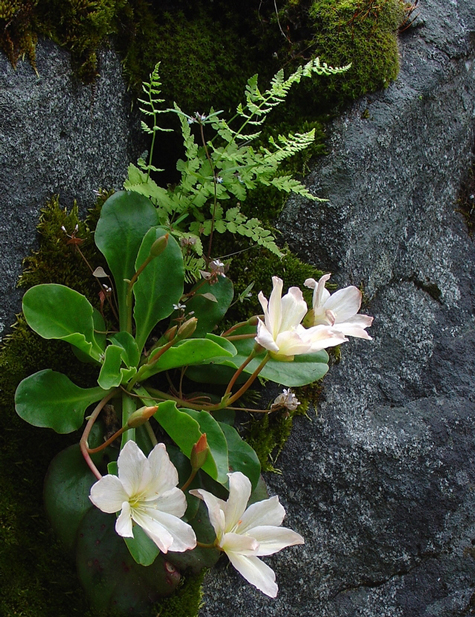
Tweedy’s pussypaws (Cisanthe tweedyi)
Some call it “the world’s premier rock garden plant”
Photo: Patent Pending Blogs
This same plant‘s also known as Tweedy’s pussypaws, Tweedy’s bitterroot, and Tweedy’s lewisia – our favorite, since it portends beloved relative Louise Tweedy.
But there are more:
Cascade Reedgrass (Calamagrostis tweedyi)
Tweedy’s Willow (Salix tweedyi).
Tweedy’s Snowlover (Chionophila tweedyi)—“found in snow beds in the alpine of central Idaho and SW Montana. Its one-sided inflorescence make identification easy.”
Frank Tweedy was a younger brother of Joseph Tweedy, our great-grandfather. One went North, one went South, but both were utterly determined to leave Plainfield, New Jersey, and strike out for the great, mysterious country of the West.
Joseph and his partners were pioneering sheep ranchers along Dove Creek, near what’s now San Angelo, Texas. He and his wife Elizabeth Mellick had four children, and about 100 of their descendants will be gathering this weekend at the adjoining Knickerbocker and Tweedy ranches.

Tweedy Mountain, north of Dillon, Montana
Photo: Summit Post
So far as we know, Frank never married or bore children. He was “one of those early unsung heroes of American mountaineering,” exploring much of the mountain northwest, sending many alpine specimens back to Philadelphia for study, and writing “the eclectic booklet “Flora of the Yellowstone National Park” (1886). The aforementioned plants, at least, bear his name, as does the highest point in Montana’s Pioneer range.
Uncle Frank might have inherited his talent for botany from one of his parents – Oliver Burr Tweedy or Maria Lord. If so, sadly, it wasn’t passed on to Joseph or to us. But genealogy, a rather telescopic form of a naval gazing and one-or-more-off method of self-aggrandizement, is also a numbers game. Among the 100 or so Tweedys to gather this weekend, we hope to find one, at least, inspecting agarita berries or squatting to observe a wildflower beside the Byler Spring.
Comments
How cool is that!!!!
The Floral Side Of Bob Dylan
By on February 28th, 2022 in
The Floral Side of Bob Dylan
Usually posed behind dark glasses, in railyards or on gritty streets, Dylan typically kept his distance from flowers, until he just couldn’t stand it anymore.

Bob Dylan with flowered hat
Rolling Thunder Revue, c. 1975
Photo: via cold splinters
Bob Dylan has outlasted so many nicer guys, better songwriters, Townes Van Zant, Tim Hardin, Steve Goodman – to name just three. Sorry. Comparisons aren’t fair, or very nice, for that matter, on somebody’s birthday. Happy 70th, Bob!
Our birthday wishes for you: a sense of humor and a better shtick than aloofness-as-significance. At 70, aloof looks way too much like demented.
We do revere many of his songs, though “his” belongs in scare quotes: Dylan borrowed lots of lyrics and tunes from old time folk, country and blues music. But who can hold that against him? Bards will be bards. They’ve always snagged whatever they loved, claiming it was only something “blowing in the wind.”
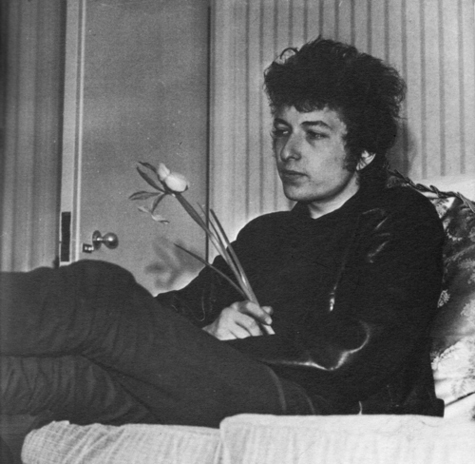
His Glumness with iris, n.d.
As one more proof of Dylan’s artful grumpiness, we note the odd absence of flowers in his hundreds of songs. (Bob Cantwell and John Landes, please correct us here!)
Purple clover, Queen Anne’s Lace
Crimson hair across your face
You could make me cry if you don’t know
Can’t remember what I was thinkin’ of
You might be spoilin’ me too much, love
You’re gonna make me lonesome when you go
This is a rarity, from 1974.
 Rose on a Hillside
Rose on a Hillside
painting by Bob Dylan
Image: Phil Turner
It’s only been through Theme Time Radio Hour, the satellite radio show that His Glumness hosted 2006-2009, that we’ve perceived Another Side of Bob Dylan. Dylan the DJ was chirpy and outright daffy, cracking lame jokes and reading out of wikipedia like the rest of us.
Thanks to Dylan aficionado Dreamtime, we learned that Dylan’s July 12, 2006 show was dedicated to flowers; he played Tiny Tim’s version of “Tiptoe through the Tulips,” The Carter Family’s “Wildwood Flower” and lesser knowns like Paul Clayton’s “The Bonny Bunch of Roses,”
interspersing these and many more songs with sprinklings of cliché, metaphysical poetry, a list of state floral emblems, and the like.
We also recalled that during the Rolling Thunder Revue tour (1975-76), Dylan adopted floral headwear. Ramblin’ Jack Elliott, also on the concert bill, claims he was the inspiration.
“I was the first one to put the flower in my hat on Rolling Thunder Revue,” Elliott told cold splinters.

On the Rolling Thunder Revue tour, c. 1975 (yes, that’s baby’s breath).
“We got into the Rolling Thunder Revue hat/flower contest, who could have more flowers in their hat. At each successive show, I’d have 3 flowers, Bob had 4. I’d have 4 and he’d have 5. We were just playing around with the makeup too. I had a heart painted on my face one time. Another time I had a tear coming out of my eye. We were like rodeo clowns. I remember when Arlo [Guthrie] asked Bob why he always had that clown white on his face. Arlo said, ‘What’s that shit on your face?’ Bob said, ‘What face?’”
Aiiee! It reminds us of the flight back from our first and only trip to San Francisco: we observed aloud to a SF native that, like Bob Dylan, Californians have no sense of humor.
Our flight-mate paused, unoffended. “You’re right,” he said. “We have a sense of the absurd.”
Comments
According to Sean Wilentz in his book, Bob Dylan in America, the Rolling Thunder Review was conceived by Dylan as a revival of vaudeville or carnival. The flowers, per Wilentz, were the fruits of that concept.
Thank you, Ross. The vaudevillian really comes through in Dylan’s radio shows too. What a ham!
I guess there really aren’t that many flower references considering the thousands of lines he’s written. But here are a few that come to mind:
Ezra Pound and T.S. Eliot fighting in the captain’s tower
While calypso dancers laugh at them and fishermen hold flowers. (Desolation Row)
People carry roses and make promises by the hour
My love, she laughs like the flowers, valentines can’t buy her. (Love Minus Zero)
When all of the flower ladies want back what they have lent you
And the smell of their roses does not remain
and all of your children start to resent you
Won’t you come see me Queen Jane? (Queen Jane Approximately)
Wonderful, John! thank you.
Gotta admit that “the smell of their roses does not remain” is poetry that does not remain in one’s memory.
But Love Minus Zero is a beauty. In one line flowers are hypocritical and in the next they are the soul of integrity.
It takes a Gemini!
… and, of course, “standing in line for your geranium kiss,” from Sad Eyed Lady of the Lowlands.
The suggestion that Bob Dylan doesn’t have a sense of humour is an indication of ignorance; the suggestion that any of these alternative songwriters are even in his class simply shows a lack of taste …………
At his best Dylan is better than any of them; at his worst, no one else is as bad. Sometimes he’s both in the same song. All IMHO.
The Azalea Line
By on February 28th, 2022 in
The Azalea Line
In the U.S., the hardiness zone for these low-growing rhododendrons has a cultural wall on the western front.
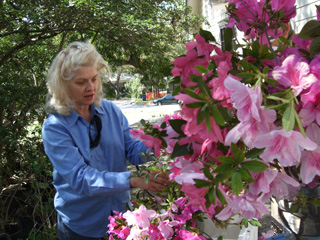
Wanda Gamble of Smithville, Texas, delivers blooming branches to an azalea-deprived Austin family
Photo: Human Flower Project
Absence makes the mind grow ruffles.
This we have discovered since crossing over from the deep soils of the East to a lime shelf in the West. Going on ten years now of alkalinity and drought, there have been tremors; a Jungian well gurgled and now gushes with the unthinkable —azalea love.
Friday our friend Wanda Gamble, painter and gardener, drove in from Smithville, Texas, to catch a few bands at the SXSW music festival in Austin. She brought home-grown vegetables and two pink clouds: scissored-open milk jugs loaded with azalea branches.
Coming up a granite path, through our new xeric plantings of agave and muhly grass, she struck us as ambassador from Xanadu. Smithville is only 45 miles east of Austin but what a difference those miles make. You can see it on the rainfall maps: Austin/Travis County, shown in medium green, averages 30-34” a year, though we’re far below that currently; Bastrop County, just east in dark green, averages 38-42” and Smithville, on Bastrop’s eastern edge, could very well be the little blue dot, with 38-42” of annual rain. On plant hardiness maps too, you can see the shift: Travis County is shown as Zone 8a, Bastrop County 8b.

Average rainfall map of Texas 1961-1990: Azalea Line seems to fall between the medium green and dark green regions.
Map: Oregon State University, via Texas Legacy Project
On the ground, this means magnolias and pecan trees that thrive in Bastrop County do well to survive here in Austin. And acid-loving plants like azaleas and camellias, which you’ll see in many Smithville yards, generally require major earth-swapping here in Travis County. Even WITH earth swapping, our camellias and azaleas have died.
We figure that azalea country lies east of this 34” rainfall boundary. For Tyler and Nacogdoches, Texas: ruby-throated yes. For San Angelo and Comstock – a raspy no. And here close to the azalea line, many sorts of problems arise: lust, futility, and denial.
Because Dallas County like Travis County lies just on the dry side of the line, growing azaleas in Dallas seems maddeningly possible. Mariana Greene, garden editor of the Dallas Morning News, writes an excellent article with the hand-wringing headline, “Are thirsty azaleas politically incorrect for Dallas?”
The city’s “unwavering desire for azaleas,” Greene explains, “dates back to the mid 1930s. According to legend, Ruth Lechner, wife of oilman Walter Lechner, wanted to reproduce the breathtaking beauty of Tyler’s residential azalea gardens at their new home at 6921 Lakewood Blvd. and the adjoining vacant lot. More than one local landscaper, however, told her it was not possible to cultivate acid-loving azaleas in Dallas’ alkaline black clay.”
Greene goes on to explain how a combination of travel, expert advice (from a Louisiana horticulturist) and significant earth moving got Ruth what she wanted, botanically anyway.
For the azalea line is also cultural. It divides the Old South from the New. In Texas alone, Tyler, Houston, Lufkin, Jasper, and Nacogdoches all hold azalea festivities. (Tyler’s website has an especially dandy feature that follows several azalea-laden yards weekly from late February through early April.) Still farther east, there are azalea trails in Wilmington, North Carolina; Pickens, South Carolina; Valdosta, Georgia; and Palatka, Florida.
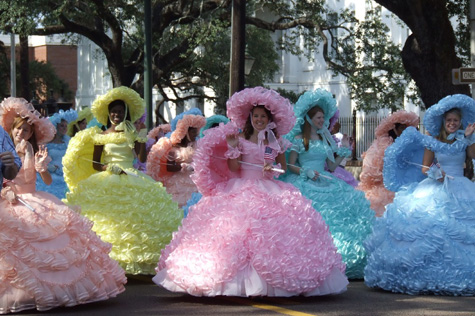
The Azalea Trail Maids of Mobile, Alabama
Photo: I Love Mobile
But the most Southrageous we’ve found is in Mobile, Alabama. Here azalea season ushers in a citywide pageant of Azalea Maids, dressed in ante-bellum costumes. “Ruffles on the edge of the hat, the edge of the parasol and the ruffle around the shoulders are mandatory.” You can pick out the Azalea Queen—the only “maid” in pink.
Should you doubt the cultural potency of the azalea line, please consider: Here on the west side, we have recently welcomed a host of web-techies, including one pair of young women who call their business Suicide Girls. During this year’s SXSW interactive festival in Austin, they decided to get tattooed with matching bacon strips.
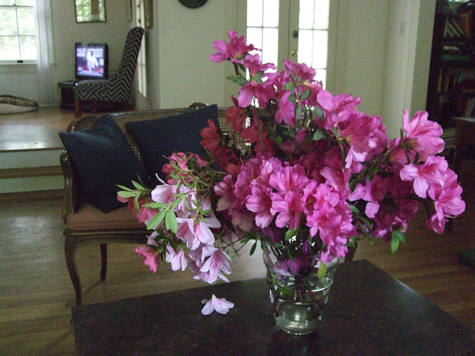
Otherworldly arrangement of azaleas, courtesy of Wanda Gamble and Bill Bishop
Austin, Texas, March 20, 2009
Photo: Human Flower Project
We have a little mnemonic device for you: “Azaleas are to agaves as parasols are to bacon-strip tattoos.”
Wanda, thank you for the gorgeous gift from your yard east of the line. In nine days of SXSW, pink ruffles have been in very short supply.
Comments
Commenting is not available in this channel entry.Sidewalks Of Delight
By on February 28th, 2022 in
Sidewalks of Delight
For 50 years, Harold Hoogasian’s flower stand bloomed in downtown San Francisco.
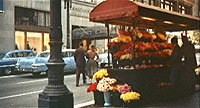 250 Post St.
250 Post St.
San Francisco
Still from the film
Vertigo, 1958
Photo: Virtual Tour of “Vertigo”
Even a city as vibrant as San Francisco really has no heart, just veins: its pulsing streets.
That’s where Harold Hoogasian worked for more than 50 years. An Armenian immigrant who moved to the city as a ten year old boy, in 1928, Hoogasian sold flowers on the sidewalks and then set up his own curbside businesses. His flower stand at 250 Post St., just outside Gump’s department store, was a fragrant landmark of downtown San Francisco.
Hoogasian died June 9, at age 87.
 Harold Hoogasian, 1918-2005
Harold Hoogasian, 1918-2005
Harold Hoogasian, Jr. said his father “was a fixture at 250 Post…, a San Francisco character who always wore a suit and tie to work, a classy guy, a true gentleman always. He always said he was a member of the upper tier of the lower class.’’ Hoogasian senior operated several enterprises around the city and even ran for mayor; his descendants still run two flowers shops.
San Francisco is famous for its character. And the flower stand outside Gump’s, a splash of spontaneity and freshness in the city’s busy center, is just what elan is made of. In his spooky Valentine to San Francisco, Vertigo, Alfred Hitchcock included a vignette at Hoogasian’s flower stand, where our nervous hero finds a blossom for his ladylove to wear.
Ten years ago, downtowners who considered the flower stand “an eyesore” tried to bump Hoogasian’s business into the alley around the corner. He fought back in court and prevailed.
Carl Nolte’s fine obituary in yesterday’s San Francisco Chronicle remarks, “The flower business, which essentially sells products that cheer people up, prospered in good times and bad.” Harold Hoogasian, fils, told Nolte, “My father always said that business was always best in an economic depression.’’
Likewise, both Hoogasian and Hitchcock saw how odd it is—and compelling—to come suddenly upon yellow chrysanthemums inside a foggy city.
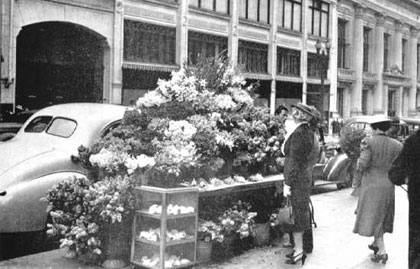
Flower stand in San Francisco, 1940
Photo: America Hurrah
Comments
Commenting is not available in this channel entry.Simple Gardening Wake Up The Energy Field
By on February 28th, 2022 in
‘Wake Up the Energy Field!’
Showman, designer, and mobile gardener Simple lets go another wonderland before an audience of plant experts, among them seedsman-writer-fan Allen Bush.
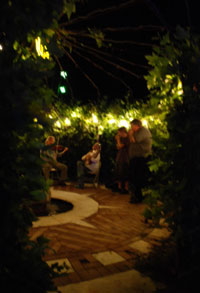 Musicians jamming in Simple’s garden
Musicians jamming in Simple’s garden
Douglasville, PA
Photo: Rita Randolph
By Allen Bush
I am impressed by those who love their gardens. I like all sorts and have shamelessly cribbed from many. I admire English gardens – especially in England – and am still trying to figure-out what a native garden can be (having planted dozens of Kentucky native species.)
My favorite gardens are kindly tended though not always thoroughly weeded. They run the gamut from fussy to messy. I confess to a fondness for plants, though in some gardens they are scarce. Few are design originals….
A few weeks ago, my next door neighbor brought over Shocking Beauty, a book written by Thomas Hobbs, the author and garden-center owner from Vancouver, Canada. There are colorful plant combinations in dazzling garden photos from Mt. Cuba in Delaware to Mount Stewart in Northern Ireland. This leads to Hobbs’s own inspired garden, surrounding his 1930s Mission Revival-style home. Toward the end he writes about an occasional epiphany, “Being overwhelmed by what you see (in gardens) is an experience that does not happen very often.” He adds, “Gardening without fear means taking risks that saner heads would never contemplate.”
…another way of saying, a garden should be fun. Simple’s is FUN!
Though Simple’s gardens have not become fodder for a coffee table book, I’d lay down a twenty and bet Hobbs would be impressed.
 Neon climbers
Neon climbers
in Simple’s garden
Photo: Allen Bush
Hobbs’s and Simple’s wonderful gardens are like night and day but when it comes to Simple’s: nighttime is the right time. Shine a light on his gardening, and it’s going to be neon – in shades of green, blue or red (You thought neon was for tavern beer signs?).
Last month the Perennial Plant Association held its twenty-sixth annual symposium in Philadelphia. It wasn’t possible for all 700 attendees to come to a garden so small, so Simple put together his own incomparable evening tour. He hired a bus for fifty friends – a payload of gardeners, designers, breeders, writers, nursery owners, plant geeks and seed industry savants.
We had been treated the day before to tours of The Scott Arboretum at Swarthmore College, Longwood Gardens, and Chanticleer. The Scott Arboretum sets a benchmark for university plantings. Their exquisite collection of trees, shrubs and herbaceous plantings is rich in breadth and quality. I’m always enchanted when I walk through the legendary Longwood Gardens. They are groomed and lavish. Chanticleer is extraordinary. There is a wealth of gardening talent here, unmatched anywhere else in public gardens.
But odds are that a spontaneous music jam featuring a violin, two harmonicas and an autoharp hasn’t happened in any of these gardens. And none has a Mongolian-style yurt fashioned out of espaliered sycamores, festooned with Christmas lighting.
Nor will you find huge bamboo clumps interplanted with tall, red neon tubes anywhere else. The sound system—twenty strategically placed indoor and outdoor speakers, some in the tree tops—is uniquely Simple’s, too. (The bones of this elaborate system are hidden in a tiny closet. Simple now prefers recorded natural sounds – waterfalls, crickets, and morning birds – that “slap you into the jungle.” It’s a pared down version of his “previous life” (garden) where five separate stereo systems could be turned-on individually to Wilson Pickett and remotely switched to Wagner when you rounded the corner.)
Our host and tour guide this evening, Simple was dressed in an outfit that bumped the Porter Wagoner look up a notch or three, into the blinking neon realm.
He loaded us on the bus and readied us for the evening with lift-off instructions: “Why not!!!… Wake-up the energy field… Something will never happen again.”

Neon amid the bamboo, Simple’s house and garden
Photo: Rita Randolph
This was Simple at his best: fun-loving showman and creative genius. It’s not always easy to understand the message, but easy-as-pie to love the ride.
As we rolled away from the hotel, he plugged in a zany self-styled 1989 video of his previous garden in Honeybrook, PA, one he abandoned after a 1991 divorce.
He held a party for that farewell, too. Guests from the gardening and botanic world came from around the country to see his exquisite topiaries, Trompe l’oeils, garden gags and water features. He sold many of the topiaries, which now grow in gardens from Long Island to Chicago. A few years later, he buried what was left.
These are happier times.
Simple is spending more time with his partner, the equally talented gardener and nurseryman Michael Bowell, who hosted us this evening for dinner in his own wonderful garden as we made our way. Simple isn’t selling his place, an old gas station near Douglasville, but has rented it out as a yoga studio; soon he’ll let his garden go and sell the current neon art inventory.
So, this was a bittersweet evening. Simple was saying goodbye to another “space in time”—as he refers to every garden. He began this one in 1998, and it has been hitched to an end point: nothing lasts forever. All our gardens will end-up some scraggly mess sooner or later.
Still, you just can’t “let go” of a garden the same way a bird nurtures her young and kicks them off the nest. It won’t fly. There is a trace of ambivalence. Simple’s ready for “another chapter,” but admits he might not let go of this garden altogether. Simple’s not worried. Come what may. He works anywhere. (He has created gardens across North America and Europe.) There are endless possibilities for new gardens – his or anyone else’s.
He gets around in a practical pick-up and drives a sporty 1990s vintage Chrysler LeBaron convertible for fun. The old V.W. bus, colorfully painted with “Simple the Roving Garden” on the side, took him coast to coast for years but sits idle in a shed.
On long trips highway patrolmen were attracted to the wild-looking bus and would regularly pull him over. There were never any tickets or arrests but there was a lot of confusion about his name. “Why don’t you have another name?” they asked.
Nothing is as simple as it seems. Simple, in name alone, is “Simple” – legally.

Simple and one pooch from the “Grass Menagerie”
Photo: Courtesy of Simple
It seems his “next chapter” – post-neon—will be producing a “Grass Menagerie.” He is creating installations of sculptured ornamental grasses wherever he goes. Figures of cats, dogs and tall people are sometimes spray painted. He loves teaching and sharing his horticultural art and enjoys working collaboratively with a clientele who know what they want but sometimes can’t explain it. His extraordinary gift allows him to interpret space brilliantly, in the blink of an eye.
We boarded the bus at eleven o’clock for the ride back into the city. Simple was staying behind and told us what we had seen was, “the way it was and never will be again… Thank you for sharing my dream… Good health.”
Comments
I’m proud to know you Simple
and glad to say you’re my friend.
PPA has been one of the best things I’ve done
for expanding me and my livelyhood.
The very best to you and yours,
Charolett
Oh, and a great big thanks to the photographers and writers taking the time and energy to put all
of this information together.
I knew it would be a magical mystery tour there in Douglasville PA and totally appreciate the efforts of whoever put this together.
I want to thank you always, Simple, for teaching me how to “see” simply when I am in a garden…or anywhere!
til I see you again
Cindy Gilberg
I was one of the extremely fortunate people to be included on that Magical Bus….. words don’t do justice to the evening, but Allen captured it as well as any poet possibly could attempt.
Simple is far from being simple; Genius would be a far better descriptor. His view of life and gardens always is skewed towards maximizing the positive and creating the unthinkable…. who else can have a flame coming out of a water feature? or turn an Ordinary gutter into a water feature adding soothing sound to the night?
His gift is to See the Hidden Magic all around us and bring it to Life.
Thank you Simple!
Good Health and a Big Squeeze!
janet draper
Ha Ha thank you all…
for enjoying my energy field of a dream that I had.. Yes it was another space in time in
“HORTICULTURAL ART”
YES THE ART OF HORTIUCLURE can be “HORTICULTURAL ART” in so may ways that we don’t even know untill we do it… Ha Ha Ha !!
I can not wait untill I have the opperturnity to do other gardens with more people that I can help their dream come true.. anywhere.. why NOT!!!
So PLEASE GIVE ME ANY COMMENTS AND IDEAL..
GOOD HEATLH
AND LOVE
SIMPLE
Six Plants People Want To See
By on February 28th, 2022 in
Six Plants People Want to See
Which plants draw a crowd and why? The EarthScholars study celebrities of the botanical world and consider how their starpower can be harnessed for good.

“It’s Superplant!”—or one of them: Monkey Puzzle Tree
Photo: David Griffin
By James H. Wandersee and Renee M. Clary
EarthScholars™ Research Group
In a recent (2009) article entitled the “10 Most Interesting Plants in the World and Where to Find Them,” Canadian garden designer Ailsa Francis names and describes ten plants she finds especially fascinating, and spots a location or two where people can observe each of her chosen plants.
Since Francis follows the streamlined format of Canada.com, meant to be concise, enticing and actionable, we don’t learn how she arrived at her ten selections—or if, besides personal preference, she used any method at all. However, we do think it’s a good list; she chose four of the same plants that our own archival and on-site research uncovered!
Botanic Gardens Conservation International, with over 500 public garden members worldwide, states that “the best estimate we have of the number of known plant species is around 400,000.” That’s a lot of “top plants” candidates! From such a wide range of alternatives, we wondered how to arrive systematically at a small list of plants that are (a) accessible to the public in multiple gardens, parks, and arboreta and (b) that historically, people most want to see—plants people actually seek out and declare their intention to visit.
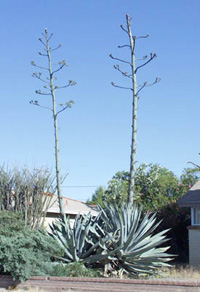 Century plant (Agave Americana) sending up flower stalks in Arizona
Century plant (Agave Americana) sending up flower stalks in Arizona
Photo: University of Arizona
We decided such plants needed a category name. At the 2001 annual meeting of the Botanical Society of America, a report by our research group defined a marquee plant as follows:
(a) A plant species that strongly attracts the public’s attention and invites its direct observation;
(b) a plant species that, during some or all of its life cycle, is capable of drawing a crowd at a botanic garden;
(c) a plant species that may serve as a portal to public understanding of plants.
To determine which species qualified as marquee plants, we set out on three avenues of research. First, we took a sample of 300 plant-related articles from the world’s leading newspapers, and through content analysis examined how writers described both the plants and their ability to engage the public. We then identified and analyzed some key visual characteristics of an emergent set of exemplary “marquee plants” commonly featured at botanic gardens—collecting information on visitation times and on-site visitor comments. Third, we composed a set of attributes derived from marquee plants that emerged in the study. We believe that botanical educators can use these plant attributes to predict other potential marquee plants, species that may be useful in teaching and promoting public understanding of plants.
Analyzing the US and European print articles about plants that drew crowds at botanic gardens, arboreta, and parks, we found six species whose media coverage length and frequency data set them apart from all other plant candidates. Open to making a list of any length, we let the data dictate the number of plants — looking for an authentic divide between the most-curiosity-inducing plants and those with more modest appeal. We found that just six plants received significantly more public attention and media coverage than our other candidates. (Ten has cultural significance in the US and some other countries; Chinese tradition holds special reverence for the number 8, associated as a homonym with “luck.”)
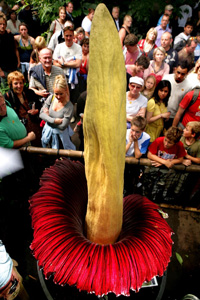 Titan Arum Plant (“Corpse Flower”) in bloom at the Eden Project, UK
Titan Arum Plant (“Corpse Flower”) in bloom at the Eden Project, UK
Photo: Eden Project
The results of our content analysis led us to study the visual characteristics of our emergent six “superstar” plants: Agave americana (Century Plant), Amorphophallus titanum (Titan Arum), Araucaria araucana (Monkey Puzzle Tree), Musa sapientum L. (Grocer’s Banana or Sweet Banana), Lithops sp. (Living Stones), and Victoria amazonica (giant Amazonian water lily).
We studied these plants on location at five famous European botanic gardens in five countries—Belgium, England, Germany, Holland, and Scotland— observing how visitors reacted to them, and measuring how long people lingered in their direct experiences with each plant. These observations allowed us to triangulate and share our findings about why the public is attracted to each of the six plants we studied.
Although the scientists and the plant science literature associated with each of these delightful marquee plants merit separate HFP articles, here we simply want you to think about what plant characteristics most attract your attention and arouse your curiosity.
Here are the sensory variables (predominantly visual) that we found in our study, in descending order of their documented attraction to humans and arousal of curiosity:
1. Variables: Inflorescence SIZE and putrid SCENT
Titan Arum (above)

UK Prime Minister Margaret Thatcher at Kew Gardens (London) marveling at the Giant Amazonian Water Lilies
Photo: Prance Family
2. Variables: Leaf SIZE and leaf SHAPE
Giant Amazonian Water Lily (above)
3. Variables: Leaf HARDNESS, leaf SHARPNESS, and leaf ANGULARITY
Monkey Puzzle Tree (1st and 7th photos)
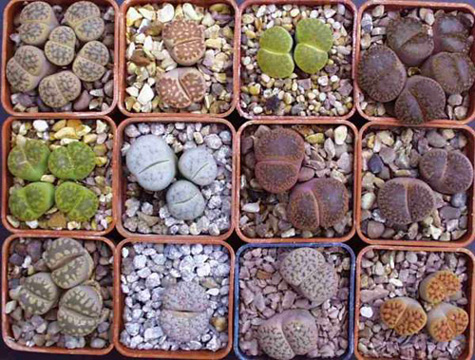
Living Stone Species Growing at UC Botanical Garden at Berkeley
Photo: Rudy Rucker
4. Variables: CAMOUFLAGE and MIMICRY
Living Stones (above)
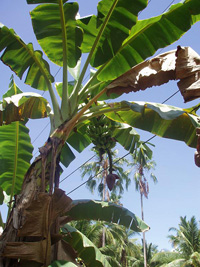 Bananas Growing in Dalahikanon, on Cebu Island, Philippines
Bananas Growing in Dalahikanon, on Cebu Island, Philippines
Photo: Dalahikan
5. Variables: FRUIT POPULARITY and PLANT UNFAMILIARITY
Grocer’s Banana Plant
6. Variables: Purported LONGEVITY, HEIGHT of inflorescence, sudden, explosive GROWTH RATE (in plant height) foreshadowing its own death
Century Plant (2nd image above)
All six of these plants are indeed “people magnets.” Julie Ardery, HFP’s founding editor, has provided an perfect example of this in her HFP essay on the public’s response to corpse flower (Titan Arum) bloomings both here and abroad in her article entitled “Rock Star.” Such bloomings have attracted as many as 55,000 people, and have even driven high volume Titan Arum t-shirt sales—with shirts imprinted especially to commemorate the visitor’s presence at this rare and impressive flowering event!
The four plants that appeared on both Ailsa Francis’ list of 10 and our own are Titan Arum, Monkey Puzzle Tree, Giant Amazonian Water Lily, and the Century Plant. The 66% agreement bolsters our confidence in our study’s findings.
Although we identified just six plants as model marquee plants, we realized their popularity may have been partially due to the fact that botanical institutions may have highlighted these plants in their press releases, marketing channels, plant tours, or on-site signage. Parks seemed to receive less media coverage, especially of their native plants. We acknowledge that studies employing other research methods might yield divergent findings as to plants and plant characteristics that attract botanical garden, arboretum, and park visitors, and arouse their curiosity.
After we completed our study, we discovered a copy of the Guinness Book of World Records containing records for the following eclectic attribute categories of wild plants: (a) tallest tree; (b) most massive tree; (c) fastest growing tree; (d) tree with the deepest roots; (e) oldest tree; (f) biggest weed; (g) most damaging weed; (h) biggest and smalliest flowers; (i) biggest orchid flower; (j) biggest leaves; (k) largest roots; (l) fastest growing plant; (m) biggest and smallest seeds; and (n) tallest cactus. What we learned from their record-categories is that those traits represent plant attributes that attracted readers of this popular, annually undated, self-reported/staff-verified record book. Later editions have added categories like plant with most leaves, heaviest apple, largest tree transplanted, and tallest rose bush.
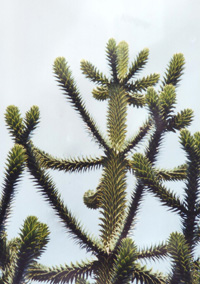 The top of a Monkey Puzzle Tree, Royal Botanic Garden—Edinburgh, Scotland
The top of a Monkey Puzzle Tree, Royal Botanic Garden—Edinburgh, Scotland
Photo: EarthScholars Research Group
Thus, from the Guinness book, we find that readers expressed their interest in the following plant traits:
1. height
2. depth
3. longevity
4. biomass
5. size
6. scent
7. growth rate
8. number
Our study uncovered the importance of all of those variables except (root) depth and number.
We did, however, document the importance of these additional plant characteritics:
9. shape
10. hardness
11. sharpness
12. angularity
13. camouflage
14. mimicry
15. fruit popularity (coupled with plant unfamiliarity)
Congruently, Ailsa Francis’ article also values plant longevity, size, biomass, and shape. She adds one more variable that makes eminent sense to us:
16. color
Interestingly, at these very five botanic gardens, we also discovered several under-publicized and under-interpreted species that harbored the potential to become “marquee plants.” If these plants could be reconceptualized, reinterpreted, and marketed as noteworthy, we predict that visitors would soon flock to see the “star quality” in each of them, as well. We also think our listing of 16 perceptual variables [above] may be helpful to those professionals interested in expanding the number of marquee plants at their botanical garden, arboretum, or park.
An example of a potential marquee plant that we’ve seen already growing in many botanic gardens is Gunnera manicata (commonly called Giant Rhubarb Plant), native to the mountains of Columbia and Brazil. Although it appears, from a distance, to be “Garden Rhubarb on steroids,” they two species are not closely related.
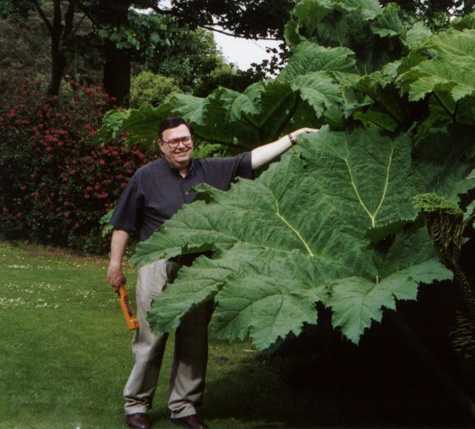
Single leaf of a young Gunnera manicata bog specimen, Logan Botanic Garden in Scotland
Photo: EarthScholars Research Group
We consider Gunnera manicata to be the terrestrial marquee plant-analog of the Giant Amazonian Water Lily. Once this land-loving Amazon is well-publicized and well-interpreted, we think the public will be fascinated by its many maximums: 10-foot height, 144-square foot spread, and gigantic green leaves that can grow to be up to 8 feet wide—what great solar collectors! The leaves’ undersides have a different color (red) and are covered with spikes, as are the 5-foot-long leaf stalks (petioles). The upper surface of each leaf is heavily textured, and the leaf’s contoured shape serves to catch and channel water to the plant’s roots.
There are “people stories” behind this plant as well. Classified by Linnaeus, he named its genus Gunnera to honor his close friend (whom he knew only via correspondence), the noted Norwegian botanist Johann Ernst Gunnerus, who was the first to study systematically the plants of Norway. Johann wrote the Flora of Norway (1766-1776). He enjoyed studying many facets of natural history—including marine organisms and the aurora borealis phenomenon. The Trondheim Society which he co-founded in 1760 (as the Bishop of Trondheim) became the Royal Norwegian Society of Sciences and Letters in 1767. Today’s Norwegian University of Science and Technology (NTNU) in Trondheim has a new research vessel, the R/V Gunnerus, named in his honor.
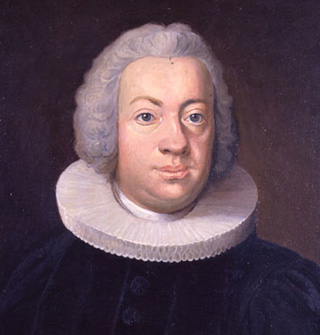 Portrait of Johann Ernst Gunnerus (1718-1773), Norwegian Botanist and Bishop
Portrait of Johann Ernst Gunnerus (1718-1773), Norwegian Botanist and Bishop
Photo: via wiki
At the macro-/microscopic level, when growing in nitrogen deficient soil, Gunnera manicata plants develop stem glands. The plants then form a symbiotic relationship with a nitrogen-fixing Cyanobacteria (Nostoc punctiforme). The bacteria enter the plant through these stem glands found at the bases of leaf stalks and then trigger an intracellular symbiosis, giving the plant fixed nitrogen in return for taking some of its fixed carbon for the bacteria’s metabolism. This “in-between-plant-cells interaction” is unique in higher plants, and may help plant scientists initiate novel symbioses between crop plants and cyanobacteria—allowing specific plants to grow in areas lacking fixed nitrogen in the soil. At present, Gunnera is the only genus of angiosperms (flowering plants) known to host Cyanobacteria (formerly called Blue-Green Algae). This is but another fascinating story to be told about Gunnera manicata.
All potential marquee plants have important tales to tell, attributes for visitors to experience, and useful plant science for people to learn. It’s up to those of us who care about increasing the public understanding of plants to expand and interpret the set of marquee plants. We can help botanical visitors to engage as many of their senses as possible, tell them memorable plant-related stories, and guide their observations through this wondrous group of green teachers.
Comments
Brilliant research protocol. I am using content analysis in my own work. (Would like to see your bibliography, if possible).
Are marquee plants similar to “charismatic fauna”?
Ready Aim Bloom
By on February 28th, 2022 in
Ready, Aim, Bloom
Allen Bush shuttles between battle fantasies, old and new, as April in the Ohio Valley loads and fires its botanical best.

Ernest Parks, re-enactor from Company I, Massachusetts 54th Regiment, tosses a wreath into Charleston (SC) Harbor toward Fort Sumter, April 12, 2011.
Photo: The Reenactors
By Allen Bush
My eyes were blood shot from tree pollen and gun smoke after a volley of blossoms and bullets. The April signal corps of redbuds, dogwoods and paw paws was flanked to the north by Civil War reenactors in Corydon, Indiana, and to the south by the Knob Creek Machine Gun Shoot near West Point, Kentucky. The reenactors understood the sorrow of war. The belligerent infidels at Knob Creek were locked and loaded. The magnificence of spring surrounded them all.
April 12, 2011 was the 150th anniversary of the Confederate firing on Fort Sumter in Charleston, South Carolina, in 1861. (Major Robert Anderson, a native of Louisville, Kentucky refused to surrender the Federal fort.) Lincoln feared this provocation for Civil War.
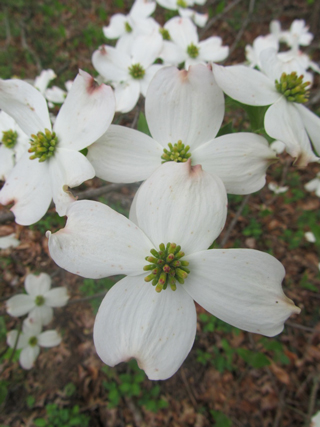 Cornus florida: dogwood
Cornus florida: dogwood
Photo : Allen Bush
The Confederacy’s secretary of state Robert Toombs warned President Jefferson Davis against the dire consequences of a Fort Sumter bombardment: “The firing on that fort will inaugurate a civil war greater than any the world has yet seen … You will lose us every friend in the North. You will wantonly strike a hornet’s nest, which extends from mountains to ocean.” President Davis paid little mind. The war was on in orchards, gardens, farm fields and woodlands for the next four years.
In his novel The Souls of Wind, John Olson describes Jack Jaffe, who’d lost his arm at the battle of Shiloh (Tennessee) in early April 1862. “He’d remembered the incident vividly: peach petals raining down like snow as they were clipped by the bullets tearing through. It made a very pretty picture until the ground became soaked with blood.”
Up north, the 35th Ohio Volunteer Infantry Company G had enlisted nine hundred members by late fall 1861. Their war effort began ingloriously. In December, fifteen soldiers skipped a skirmish and wandered off for the afternoon to collect persimmons. The Confederates captured them. The 35th became popularly known as the Persimmon Regiment. By the Battle of Chickamauga in September 1863, the regiments’ numbers had been cut in half.
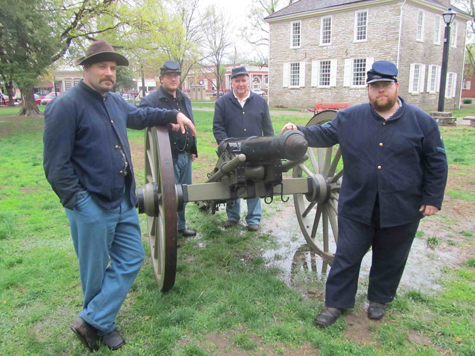 Reenactors of the 35th Ohio Volunteer Infantry Company
Reenactors of the 35th Ohio Volunteer Infantry Company
(l-r) Jason Hawley, Kevin Anderson, Bill Fuller, and Josh Moffett with puddles and a Model 1841 6-pounder Smooth Bore cannon in Corydon, Indiana, April 9, 2011.
Photo: Allen Bush
Bill Fuller a mechanical engineer from Sidney, Ohio was in Corydon, Indiana, on April 9th with twenty-one reenactors of the 35th Ohio Volunteer Infantry Company. Late Saturday morning, he sought shelter from hail and driving rain inside the old Indiana state capitol. Fuller has been standing at attention on weekends with his re-enactors for ten years. He enjoys educating school groups who come to see the Union Soldiers, but he also appreciates a few creature comforts, apart from the weekend battlefield. Staying dry is one of them. And lunch at the Real Enchilada, off the Corydon town square, better suits members of the regiment than “hard tack and salt pork.” One rebel reenactor, interviewed in Tony Horwitz’s Confederates in the Attic, sought a “time travel high” by soaking his buttons in urine and creating a perfect 1860s patina. “My wife woke-up, sniffed the air and said, ‘Tim you’re peeing on your buttons again.’” Fuller admits with a smile that he is not after a “period rush.”
Fuller, like many from the Ohio Volunteer Infantry reenactors, is a student of the Civil War. A bayonet, he explained, was a great foraging tool for potatoes and carrots. Fuller also told me soldiers occasionally gorged on fresh fruit and suffered the consequences of diarrhea – the “Old Soldiers Disease.”
Michael Shaara, in his novel The Killer Angels, describes the misfortune of the British tourist Arthur Fremantle who was traveling with the Confederates at Gettysburg. ”Freemantle felt a familiar rumble in his stomach. Oh God, not the soldiers disease. Those damned cherries…Soldiers [who] had observed him hanging in the air like a plump gray fruit were beginning to point and grin. Fremantle descended with dignity….”
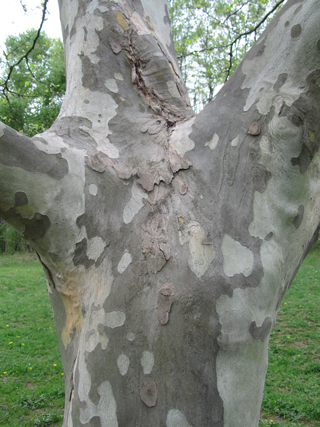 Platanus occidentalis: sycamore
Platanus occidentalis: sycamore
Photo: Allen Bush
There was no dignity the next afternoon on July 3, 1863. General Robert E. Lee badly miscalculated and ordered Pickett’s Charge. By day’s end 50,000 soldiers, from both sides, lay dead from the three-day battle. The Northern Army of Virginia went home.
Lee surrendered to Ulysses S. Grant on April 9, 1865 at Appomattox Courthouse, Virginia. 600,000 died during the Civil War that spanned four spring seasons. The Confederacy’s Secretary of State Robert Toombs had been right all along. “Legions now quiet will swarm out and sting us to death.”
Kentucky had chosen not to secede from the Union and tried to stay neutral, but the war took a toll. Joe Creason, Louisville Courier-Journal columnist, wrote about Kentuckians’ conflicted loyalties: “Those who fought were generally unable to agree why they fought. A sense of duty to family, loyalty to tradition, devotion to honor were intangible emotions shared by soldiers of the North and South alike. Both parts of the warring nation were sustained likewise by the same firm conviction that theirs, and only theirs, was a just cause in the sight of God.”
 Aesculus flava
Aesculus flava
the yellow buckeye
Photo: Allen Bush
I drove south, in the afternoon for the semi-annual gala of automatic weapons with my brother-in-law, his teenage son and a friend. The Knob Creek Gun Range is little more than 20 miles from Louisville, down “Wide, Wide Dixie Highway.” Past Shively, Valley Station and a few miles beyond the cement plant at Kosmosdale, you’ll see a rusting sign on the right (“Dancers Wanted”) in front of the Rivergirls Lounge. Bullitt County is just ahead.
Take a sharp left onto Kentucky Hwy 44. Very soon, even if you’re stone cold deaf, and can’t hear the 50-caliber machine gun staccato thump, thump thump; you can’t miss the hundreds of cars, with license plates from as far away as Texas and New York, parked along both sides of the road. If you are paying any attention, you’ll see the chartreuse flowering tassels on sugar maples lighting-up the knobs. The crooked limbs on riverside sycamores can’t be camouflaged. You can sight these trees from long range, before leaves emerge, without the scope on a M1918 Browning automatic rifle. The cockscomb blooms on a lone yellow buckeye, halfway up the hill, would take a good marksman to spot. (Did anyone see any dogtooth violets, Trilliums or ramps?)

Gunning with new artillery at the Knob Creek gun Range, Bullitt (truly) County, Kentucky, 4/9/11
Photo: Allen Bush
Following prayers for fallen soldiers and the National Anthem, the spring sharpshooters began skirmishing with propane tanks, old refrigerators and jeeps on the anniversary of the Civil War surrender. Bombs bursting in air.
Comments
Raining bullets and beautiful flower petals…such an amazing image. Thank you cousin Allen for such a brilliant article! I am visiting with the Ardery family awaiting the opening of the peonies.
Collis Marshall
Thanks, Collis. Happy Derby Day! I don’t why they bothered calling the race the Run for the Roses. My few garden roses are bug eaten already. The Run for the Peonies suits this time of year a whole lot better.
Allen you would like Seeds by Richard Horan. There is a great section on some young trees now old – American sycamore, tulip poplar, etc. – at Gettysburg.
Georgia, I picked-up the book on your advice and have enjoyed reading this very much. Right-up my alley. Thanks very much
Rooting And Flowering For The Cardinals
By on February 28th, 2022 in
Root, Flower, for the Cardinals
Few businesses offer the amenity of fresh flowers. One St. Louis restaurant owner holds firm, and buys the blossoms every week himself.

Always packed, and ever with fresh flowers, Charlie Gitto’s is a downtown institution in St. Louis, Missouri
Photo: Human Flower Project
Following flowers this year has led us to follow baseball – thanks to Charlie Gitto, we have a team.
Charlie operates two well known Italian restaurants in St. Louis and for the past thirty years has bought the establishments’ fresh flowers himself. We wound up at his downtown spot thanks to the recommendation of a friendly custodian at Busch Stadium. There actually aren’t too many restaurants open in this part of the inner city at night, so we were thrilled to find Charlie Gitto’s on North 6th Street, a healthy but easy walk from our hotel.
There was a short wait, but we settled into the pretty old foyer – tile floor and lots of polished wood. There was a big vase of gladiolas on the counter just inside the door and, of course, the game was on TV. We looked up at scores of framed photographs of baseball heroes, musicians, pols, and the Budweiser clydesdales, all posing with the same mustachioed gentleman – the fellow who happened to be sitting at the end of the bar watching the game.
“I buy go to the flower market every week,” Charlie told us proudly. There he picks up enough stems for the tables and a big bouquet up front, plus “two dozen white roses for my daughter.” (St. Louis still has a busy downtown flower market on the 2700 block of La Salle Street. You can watch a youtube about the market here.)

Charlie Gitto with red and white glalds he selected himself to decorate the restaurant. St. Louis has a thing about red and white – a BIG thing.
Photo: Bill Bishop
Charlie Gitto’s is a hometown delight, three decades in the business of serving cannelloni and meat balls. The waitresses are “seasoned,” and the clientele is a comfy mix of families, business types, romantic couples, and travelers, like us. With alstromeria on all the tables, that lovely floral workhorse of the restaurant world, you’d never mistake this for a “sports bar” or Hooter’s. And at nine of a Saturday night, Charlie’s still here, presiding quietly and very, very glad somebody’s admired his flowers.
We’re confident that tonight the flowers on the counter are likewise red and white: Charlie’s favorites, and team colors for the Cardinals. Getting a table will be impossible.
St. Louis is behind 0-2 in the National League Division Series, but, ah, tonight is different. The Cardinals play the Los Angeles Dodgers at home, 5 pm CST (that’s now!). Busch Stadium is sold out and a few blocks away Charlie Gitto’s is, no doubt, fully floral and on fire with fans!
Late note: Ouch! The Dodgers swept our team, 3-0, in the division series, winning tonight in St. Louis 5-1. Bummer for the crowd down on N. 6th street.
Comments
Commenting is not available in this channel entry.Roots And Shoots Priority Gardening
By on February 28th, 2022 in
Roots and Shoots: Garden Priority
Education, like great gardening, is high-maintenance work. A London school reaches out to children with special needs, turning out honey and horticulturists.

Inner city campus? Roots and Shoots is a gardening
school + in the Lambeth neighborhood of London
Photo: Courtesy of Roots and Shoots
By Allen Bush
There’s a little piece of wonderland in London, England. It’s not far from the Houses of Parliament and only a short walk from Waterloo Station. Roots and Shoots, a model gardening school, is tucked away off a side street, hidden behind council flats in Lambeth, in a neighborhood of Georgian and early Victorian houses.
When I visited in late May, Environmental Education and Resources Manager David Perkins was introducing a visiting school group to bees, bugs and baby birds. Smiling faces prove that something good was going on.
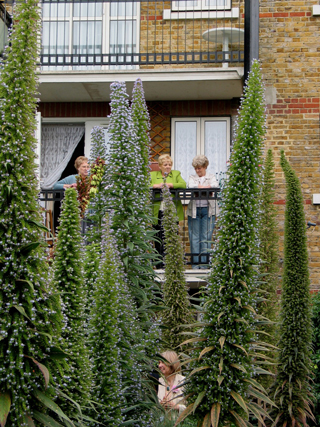 Linda Phillips, director of Roots and Shoots, walks among huge Echiums, native to the Canary Islands
Linda Phillips, director of Roots and Shoots, walks among huge Echiums, native to the Canary Islands
Photo: David Perkins
The best gardens are full of surprises. Towering Echiums (E. pininana), native to La Palma in the Canary Islands, seem remarkably at home in the fast draining clay-shale soil. Director Linda Phillips led me beyond the environmentally friendly Learning Centre, with solar collectors atop a partial green roof, along a narrow winding path past musk roses and beehives, into the wildlife garden. Eventually we reached the far end of the one-acre property, arriving at Blake’s Corner, surrounded by Acanthus, rosemary, and Phlomis. (William Blake lived nearby on Hercules Road and – rumor has it—occasionally enjoyed sitting naked in his tree.) A Blake quotation on the wall here sums-up the lessons from this schoolyard: “In seed time learn, in harvest time teach, in winter enjoy.”
Phillips could not have known how her vision of a garden school would expand —to include seven species of bumble bees, plus zebra and crab spiders. A wealth of plant species provides enough nectar and pollen for Painted Lady butterflies, Jersey Tiger Moths and plenty of honeybees. Gardens and children require nurturing and lots of time. Forget the nonsense that gardens can be low maintenance. The marketing mantra “Plant ‘em once, never worry about ‘em again” is fairy tale, as dubious as saying Latchkey Kids can’t fail.
The 25 students at Roots and Shoots, mostly from the boroughs of Lambeth and Southwark, arrive with learning, social or emotional problems. These children could have fallen through the cracks, but the committed Roots staff, in Linda’s estimation, “are fantastic at taming and turning their lives around.”
Though the 40-week course has become more complex over the years, there has always been a core focus on the environment, physical work, team effort and community involvement. Included now is a ‘holistic’ plan developed for students ages 16 +, a government-certified curriculum of math and English as well as horticulture. In addition, training in life skills prepares some students for the retail trade.
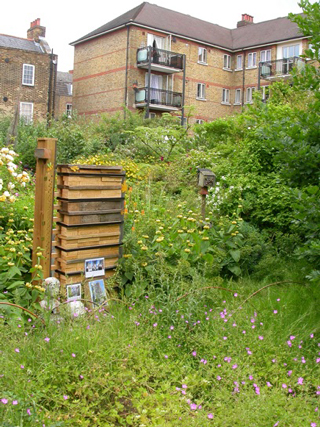 Student-beekeepers harvested 80 pounds of honey last year
Student-beekeepers harvested 80 pounds of honey last year
Photo: Courtesy of Roots and Shoots
Overarching this program is an infinite daily variety that reflects the wonders of nature and the garden. It doesn’t do Roots and Shoots justice to say it is merely a Gardening School. It’s a model for a good life. Socrates would have understood the virtue of honey produced from the school’s five hives and enjoyed the fresh organic apple juice. (80 lbs. of honey was produced last year, and the students pressed over 700 bottles of “Orchard Bounty” from ‘Ashmead Kernel,’ ‘Bramley’ and Monmouthshire Green’ apples produced by friends Gayle and David Whittingham from the Usk Valley in Wales.) After a taste of the Good Life, some of these young gardeners have found placements at the Buckingham Palace Gardens, Grosvenor Estates, the Royal Hospital Chelsea and the Chelsea Physic Garden.
 The school’s one acre site “before”: 1984
The school’s one acre site “before”: 1984
Photo: Roots and Shoots
Roots and Shoots might not have become a garden school at all except for Linda Phillips. At her job interview she was told about an idea the sponsors had for raising rabbits and raspberries. The rabbits would provide fertilizer for raspberries and meat could be sold to raise funds. It was an interesting sustainable notion, but Linda counter-offered. “I have a better idea,” she said. “I envision a horticultural nursery where we can sow seeds and grow liners for sale.” She got the job and a derelict site, then set-up an office with a cardboard box. “I was very lucky to have free rein,” Phillips acknowledges. But freedom was a token concession; she knew she would need to live by her wits. Roots and Shoots would require as much pluck as gardening know-how. “I was thrown in the deep end on social work,” Linda confessed.
As with any non-profit, there have been nagging light bills and responsibilities for making payroll. Phillips has not been afraid to raise money for operating expenses and for capital improvements, too; she’s made it for more than 25 years, even during some lean times when the end looked near. In 1994, with news that crucial government funding might be cut, Linda jumped into action. “We eventually had a petition of 60,000 signatures,” she said. “The trainees waylaid people on buses, trains and in the street to get the support, and it was delivered to 10 Downing Street.”

Linda Phillips with Quercus robur at Roots and Shoots. In 1994, the lean Thatcher years, the school needed to attract publicity and raise funds. MP Kate Hoey planted this English oak, the students, staff and supporters collected 60,000 signatures, and Hoey pressed the school’s case in Parliament. Today, both the school and the oak are thriving.
Photo: Allen Bush
Kate Hoey, MP from Vauxhall (that encompasses the London Borough of Lambeth) and a long-time supporter of Roots and Shoots, raised the issue in Parliament. The arms of civil servants were twisted and a little breathing room was found. The City Bridge Trust agreed in Spring 2009 to fund Phillips’s post for three years. Linda laughed that some of this money originated from investments going back 800 years, when the City of London charged the Tower of London a shilling each time the severed heads of the prisoners were displayed on London Bridge.
Linda praises the Roots Staff: “David Perkins, Education Coordinator Ruth Mitchell and Administrator Elsa Cole, in fact all staff are very wonderful and committed, especially given we can’t afford to pay them a great deal – such is the joy of the voluntary sector, hence my endless search for funding.”
Phillips, a native of Twickenham, Middlesex, has impressive roots. “My grandfather was the head gardener for Reston House,” a Victorian villa of about 6 acres, now the site of 1930s semi-detached homes beside Kew Village, near the railway. Linda’s mom, one of nine children, grew-up nearby in a small cottage on Sandycombe Road. So Linda got an early start.
“I had my first garden when I was 3 years old and used to buy amateur gardening magazines with my pocket money. I must have been a rather strange child who would rather gaze at Mr. Nightley’s garden next door who had a greenhouse…my dream! I was eventually very lucky to get a ‘classical’ horticultural education—not really available these days—from my late teens on.” Phillips speaks modestly about her impressive credentials, that include time at Hampton Court and a Diploma in Horticulture from the Royal Botanic Gardens at Kew.
Yet her qualifications run deeper. “My mother was a political activist, and instigated in me a deep social conscience that re- emerged with my work at Roots. I realized that horticulture went hand in hand with social work. I had a once in a lifetime opportunity to do something with my horticultural expertise and make a lovely place for everyone to enjoy.”
And plenty of visitors do enjoy Roots and Shoots (a name conceived in a nearby pub one Friday at lunch). 1150 visiting children spent 2500 hours learning in the Wildlife Garden last year.
Aude de Leidekerke arrived at Roots and Shoots from Belgium as a casual volunteer. Intelligent and articulate, she’d considered architecture and floristry, but she was not quite sure what she wanted to do. Phillips talked her into horticulture. She applied for the Diploma Program at Kew and was turned down. She needed more practical experience, and Linda sent her to friends Sarah Wain and Jim Buckland at West Dean Gardens. Aude stayed two years there, got on the Kew Course and graduated with Phillips in attendance, as she says, “…in loco parentis and I’ve never been so proud.” After working on Green Roof research with Nigel Dunnett at Sheffield University, Leidekerke is currently setting-up a business as Green Roof consultant and garden designer.
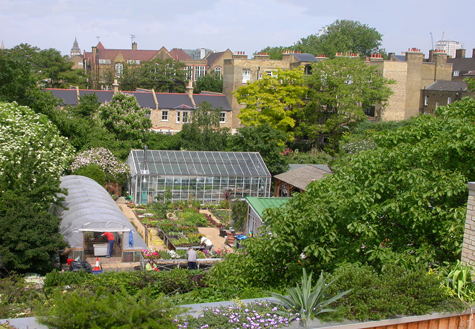
From the roof on the new Learning Center at Roots and Shoots, 2006
Photo: Courtesy of Roots and Shoots
Phillips admires the work of Will Allen of Growing Power whose success in community gardening in Milwaukee, Wisconsin, is now being modeled elsewhere around the United States. Will Allen has been hard at it for over fifteen years. Linda Phillips is no Johnny-Come-Lately to gardening or community organizing, either. This year Roots and Shoots received the Sustainable Cities Access Award – London’s “Green Oscar.” The citation read: “Over the years, they have transformed this ex industrial site into an award winning wild life garden and eco-centre, and when their extensive work with the local community, on issues such as sustainable food production and biodiversity, are taken into account, it is apparent that this gem of a project is a worthy winner of this category.”
Phillips envisions an expanded role for Roots and Shoots. She wants to improve the volunteer program, do more community gardening, educate more people, provide more environmental training and spread the net wider. “We’re limited now by the numbers of staff, but the quality we have is excellent,“ Phillips said. “We can do more. I believe in a better quality of life. It’s within reach.”
Comments
Impressive all around. How fortunate for the “casual volunteer” whose path through Roots and Shoots led her to work with Nigel Dunnett!
Great post! The Farm to School movement in the USA is promoting this sorta thing as well. We feature some great examples of schoolyard gardening on our blog, check them out, http://blog.baybackpack.com/?tag=gardening
Thank you Georgia and Krissy. Roots has been a great blessing for lots of kids and I’m excited to read about schoolyard gardening.
Saved By The Eryngium
By on February 28th, 2022 in
Saved by the Eryngium
Seduced again by tulips, an amateur flower arranger reaches for something rubbery and something wild.
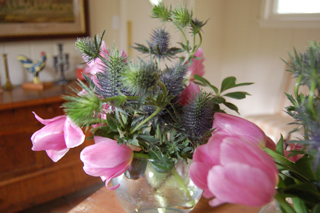
Pittisporum, tulips, and (praise be) eryngium
Photo: Human Flower Project
Hubris, failure, luck: The annals of amateurism are filled with these.
May we add another chapter? Today is a friend’s monumental birthday, a milestone we have yet to reach. Another great chum and world-class hostess is having the quasi-surprise party, a dinner at her home, and we volunteered to bring the flowers. Earlier in the week we hit “Family Thrift” and the St. Vincent de Paul store looking for some low, matchable-ish vases and today set out at noon to shop for flowers.
The hostess’s domain is saturated in bold rich colors: black, deep purple, reds, greys and dark greens. We had those regal shades in mind browsing the plants and flowers at the market. Five big purple and white orchids would have been swell but we pulled back. They’re pricey and so tall guests would be craning for conversation during the meal. The market was especially well stocked — many shades of roses, proteas buds (looking a bit too much like medieval flame throwers), lilies, lots of berries, even big purpling bouquets of kale.
There were also loads of tulips—white, red and purple—some tear-drop tight, other beautifully open. That was it. We bought five bunches and, on added impulse, several stems of a thistle-looking plant. As several tulip petals flew off in the wind on the way to the car, hubris began chafing.
Back home we settled the tulips and thistles into a kettle of lukewarm water, grabbed clippers and headed out to the yard for pittisporum leaves, a super companion for about any flower. They actually grow radially and look like green florets, shiny and less klunky than magnolia leaves. Thanks to a heavy rainshower yesterday, the little branches were especially fresh.
Ah, assembly! Yes, we had vaguely anticipated there might be a problem getting the flowers to stand up in these glass globes (which is why most arrangements you see with these vases are packed in a la sardine). Wasn’t there a wad of chickenwire somewhere? There was a tussle with the wire cutters – spousal instructions somewhat helpful. There were several attempts at chickenwire application – on the bottom of the vase? on the top? under the top? inverted? None too sure of the armature, we plunged ahead, dissolving the little packets of plant food in water and ripping the cellophane sacks from the tulips.
Clipping the bottoms of the stems and dropping them into the glass vases, we heard an old, familiar whine in the distance – the big Failure siren was closing in! How could we have forgotten the great defect of tulips. Their terrible posture!
The next 20 minutes were frenzied, angry, self-recriminating. Each arrangement looked worse than the last, as if the flowers had all been stricken with palsy and were now trying to slink their way out of this social obligation altogether. (We know the feeling.) Did we need to “wire” the tulips so their heads would stand up? Who has time to wire 50 flowers, and who with two centuries of time knows how to do that anyway?
By reflex, we reached for one of those tools of desperation—in the same kit-bag as the staple gun and Krazy Glue: the rubber band. We bunched and banded the pittisporum branches and tulips together like pony tails and replopped them in the vases. Pretty bad, but less awful. Now at least some of the flower heads were upright.
The kettle in the sink still held two big bunches of thistle. What the hell. We pulled that out, chopped it it off and dropped several stems into each vase. And all that had been so feeble before suddenly was passable. These flowers now, as T.S. Eliot once put it, “had the look of flowers that are looked at.” (You might even miss the old brown rubberbands.)
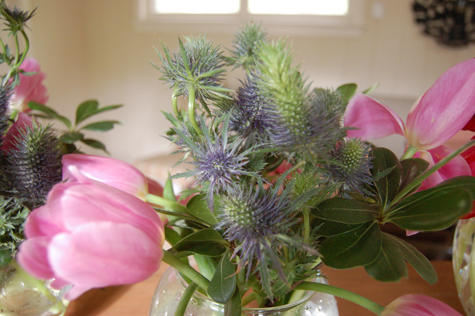
Blue eryngium—though which blue eryngium, we’re not sure—gives a boost to langourous tulips
Photo: Human Flower Project
We had been saved by Blue Eryngium, a plant we’d seen growing wild before but known nothing about. It turns out that sea holly, as its more commonly known, grows well in Texas, and you can be sure we’ll be looking for some to plant in the garden. The spinyness of it, the bluish cone shapes and slight duskiness were ideal here, a fine contrast to both the deluxe color and droopiness of the tulips and the shiny pinwheel green of pittisporum.
And talk about good posture!
Geyata Ajilvsgi in Wildflowers of Texas describes Egyngo (Eryngium leavenworthii) as “upright, rather slender, prickly.” Which also perfectly describes tonight’s guest of honor. We hope she’ll be pleased.
Comments
I’m glad your bouquet worked-out for the special birthday! I fell in love with Eryngium leavenworthii the first time I saw plants in a garden on the east coast six or eight years ago. I got some seeds from the North American Rock Garden Society seed exchange the next winter. I hoped that Jelitto Perennial Seeds, my employer, might be able to offer this for sale one day. I needed to grow a few plants to produce seeds for their trials. I imagined it wasn’t well known outside its native range. Though Jelitto offers a wide selection of perennials, including quite a few perennial Eryngiums, annuals are not a big focus. And Eryngium leavenworthii is an annual but a beautiful species. It flowers, sets seed and dies after one season. However, it does self-sow in my dry scree garden but they sometimes take two years to germinate. That’s not so unusual for some perennials but it’s not a big selling point for an annual. Seed production stalled. One day I walked across the street from the Jelitto office to the coffee shop and found an arrangement of these gorgeous blooms. I asked where they’d gotten them. I was astonished to see them here. They said one of the local wholesale florists delivered them. The clerk had no idea which one. I wondered if they might be locally produced. After a random search (No one knew the cut flower by Eryngium or Sea Holly) I finally tracked down the local wholesaler after describing the flowers. He told me they’d come from a South American cut flower grower! Jelitto was eventually able to offer seed in their catalog.
Dear Allen,
Thank you, thank you, for all this added information about how to get Eryngium seed—and your own fascinating efforts to make that seed more widely available. If only we could get florists working more closely with local growers, and make the best of our bounty!
I’d also be interested to know how leavenworthii differs in looks and hardiness from the eryngium perennials.
We always welcome your tales of untold horticulture.
X
J.
Hey, Julie—
The flowers of Eryngium leavenworthii resemble other Eryngo species but have flowering parts with a color range from white to steel blue to purple. Most can be recognized by their prominent flowering cone and decorative bracts that resemble petals. Hardiness is largely a function of native provenance. This rain-soaked summer E. leavenworthii got a little ungainly in Kentucky. I pinched mine once or twice so they wouldn’t get tall and floppy. My guess is that they’re adapted to dry summers.
We’ve finally gotten a hard frost…
Allen
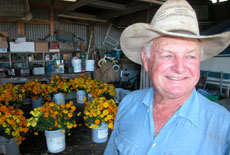

Congratulations, Julie! I’ll have to ask my family at the next gathering.